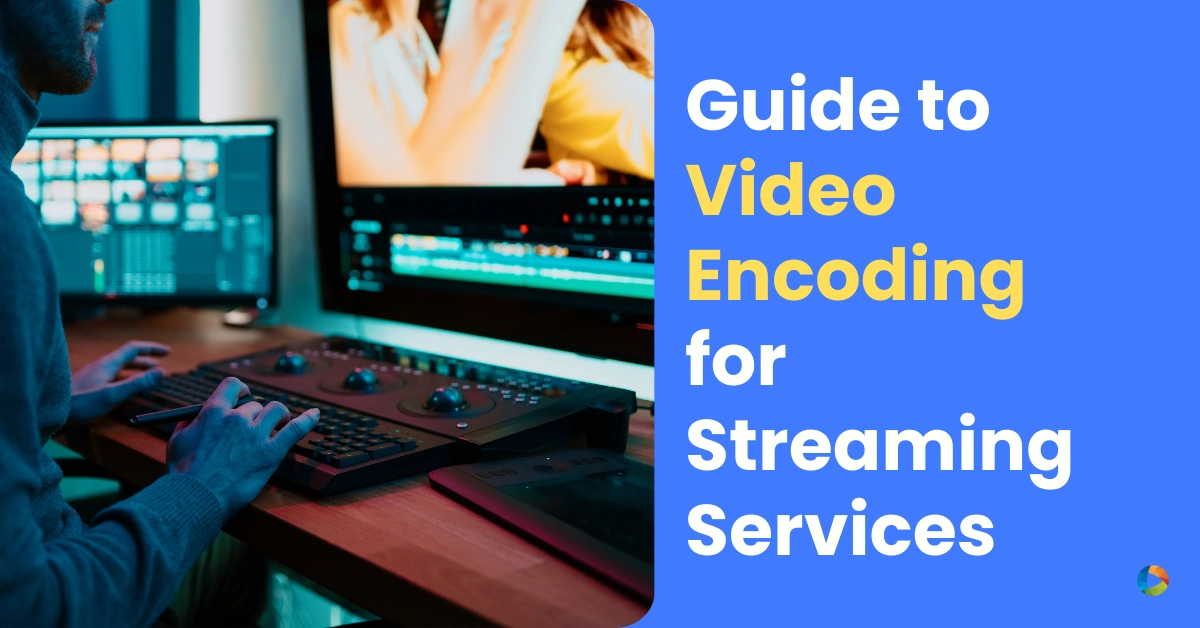A Guide to Video Encoding for Streaming Services
Last Updated on May 23, 2025 by Anjana Devi
In the bustling world of streaming services, making sure viewers can enjoy their favorite shows and movies without any hiccups is key. Imagine watching your favorite series, only to have it constantly buffer or look blurry. Frustrating, right? That’s where effective video encoding comes in. It’s the secret sauce behind smooth playback, reducing those buffer times and making sure your content looks great on any device.
For streaming service owners and those dreaming of starting their own streaming business, understanding video encoding isn’t just about keeping viewers happy—it’s also about saving on bandwidth costs, catering to different devices, and ultimately, making your service stand out in a crowded market.
Let’s dive into why getting video encoding right is so crucial for your streaming success.
Why Does Video Encoding Matter?
Encoding ensures that your content plays seamlessly across all devices and internet connections, keeping your audience glued to their screens.
Phones, tablets, CTVs—your audience watches on various gadgets. With adaptive encoding, you can ensure your videos look great on every device, keeping viewers from hitting that dreaded buffering wheel.
Bandwidth costs can add up fast, especially for streaming services delivering high-quality video content to a large audience. That’s where optimized encoding comes into play. By compressing video data and shrinking file sizes, encoding makes your videos internet-friendly, keeping your bandwidth costs in check.
The Core Concepts of Video Encoding
Video encoding may sound like a complex topic, but let us break it down. Video encoding revolves around two key concepts: codecs and their selection.
Codecs are the tools that compress video data while aiming to maintain quality. It’s like squishing a large balloon into a smaller one without losing too much air. Each codec, such as H.264, HEVC, VP9, or AV1, has its way of achieving this compression.
Selecting the appropriate codec depends on factors like device compatibility, streaming platform requirements, and desired video quality.
For example, if you need compatibility across a wide range of devices and platforms, H.264 might be the best choice. However, if you’re focused on maximizing efficiency and quality, HEVC or VP9 could be more suitable. It’s about finding the right balance between compatibility and efficiency for your specific streaming needs.
H.264 (Advanced Video Coding)
H.264, also known as Advanced Video Coding, is a widely adopted codec for its efficiency in compressing video data while preserving good quality.
This codec is versatile, finding its place in various applications such as streaming, broadcasting, and video conferencing.
Moreover, it is compatible with most devices and platforms, making it a popular choice for content delivery.
Whether you’re binge-watching your favorite series or tuning into a live stream, chances are H.264 is behind the scenes, ensuring your videos look great no matter where you are. It’s like speaking the universal language of video encoding, understood by everyone, everywhere.
HEVC (High-Efficiency Video Coding)
HEVC, also known as H.265, steps up the game by offering enhanced compression efficiency when compared to its predecessor, H.264.
With HEVC, you can enjoy smaller file sizes without sacrificing quality or opt for higher quality at the same bitrate.
This codec can be used to save some bucks when it comes to ultra-high-definition (UHD) content and streaming services. If bandwidth efficiency is crucial, HEVC ensures smoother streaming experiences and sharper visuals.
However, despite its advantages, HEVC adoption may be limited by licensing issues and compatibility concerns with older devices. It’s like having the latest gadget that not everyone can use—impressive, but not accessible to everyone just yet.
VP9
VP9, developed by Google, is an open and royalty-free video compression format, offering an alternative to codecs like HEVC.
This codec boasts similar compression efficiency to HEVC but without the licensing constraints. In other words, you get the same high-quality compression without worrying about licensing and compatibility issues.
While VP9 generally offers good compression efficiency, it may not consistently match the performance of HEVC in all scenarios or with certain types of content. In some cases, VP9 could produce larger file sizes or lower-quality output compared to HEVC, which could impact the overall streaming experience for viewers.
Despite VP9 being widely supported by major web browsers and streaming platforms, its adoption may not be as extensive across all devices and software ecosystems. This could lead to limitations in certain contexts, particularly in environments where support for VP9 may be limited.
So when considering the use of VP9 for video encoding, carefully evaluate your needs and requirements, ensuring it aligns with your goals for content delivery and quality.
AV1
AV1 stands as a next-generation, open-source video codec developed by the Alliance for Open Media (AOMedia).
Designed to provide substantial improvements in compression efficiency compared to previous codecs like VP9 and HEVC, AV1 is considered a promising option for future-proof video encoding solutions with bitrate efficiency.
While its widespread adoption may take time, the potential benefits it offers make it an exciting prospect for streaming services looking to stay ahead of the curve in delivering top-notch video content.
Containers
Containers are digital wrappers that hold various elements of multimedia content together in a single file format.
Containers are like virtual boxes that wrap video, audio, subtitles, and metadata, ensuring seamless playback across different devices and platforms—into a package. This packed unit simplifies the playback process for devices, enabling them to access all required components efficiently.
Selecting the right container is crucial to ensure compatibility across devices and platforms. By opting for a widely supported container, you can guarantee that your video content will be playable on various devices without any compatibility issues.
MP4 (MPEG-4 Part 14)
MP4 stands for MPEG-4 Part 14, is a widely used digital multimedia container format.
MP4 is capable of encapsulating audio, video, subtitles, and still images within the same file. This means you can have all the components of your multimedia presentation neatly packaged together in one convenient format.
MP4 files typically carry the .mp4 extension and is supported across a wide range of devices, operating systems, and media players. This ensures that your content can be accessed and played back smoothly across various platforms without any compatibility issues.
This widespread compatibility makes MP4 the ideal choice for distributing content over the internet, ensuring that your videos can reach a broad audience without any technical hurdles.
Whether you’re sharing videos online or distributing them digitally, MP4’s versatility and compatibility make it a reliable container format for multimedia content.
MKV (Matroska Multimedia Container)
MKV, or Matroska Multimedia Container, is an open-source container format known for its flexibility, allowing it to house an unlimited number of audio, video, subtitle tracks, and metadata within a single file.
MKV has the .mkv extension and is an ideal choice for handling complex multimedia content, such as movies with multiple audio streams or TV series with diverse subtitle options.
While MKV may not enjoy the same level of universal support as MP4, it offers distinct advantages such as support for multiple audio and subtitle tracks, chapter markers, and embedded metadata. These features cater to specific needs, appealing to users who prioritize customization and flexibility in their multimedia content.
Striking the Right Balance: Quality vs. Efficiency
In video encoding, finding the perfect balance between quality and efficiency is crucial for delivering great viewing experiences while managing resources effectively. Here’s what it mean
Balancing quality and efficiency involves carefully considering encoding settings like bitrate, resolution, codec choice, and compression techniques. These settings determine how the video looks and how much data it uses.
When you encode your content, you have to think about the trade-offs between achieving the best visual quality and using resources wisely for smooth playback. It’s like finding the sweet spot between having a super sharp picture and not using too much internet data.
This balance is especially important for streaming services. As you need to deliver top-notch content efficiently to keep viewers happy, minimize buffering, and ensure playback is smooth. It’s like making sure your favorite show plays without any pauses or interruptions.
To strike this balance, advanced encoding technologies, adaptive bitrate streaming, and smart encoding algorithms come into play.
What Is Bitrate?
Bitrate determines the quality of the videos your viewers will experience. Let’s break it down
Think of bitrate as the speed at which video data flows. Higher bitrates mean smoother, clearer videos, while lower ones can result in less detailed or pixelated images.
High-bitrate videos demand faster internet connections and enough device processing power and storage capacity to stream smoothly. If your viewers have slower internet speeds, they may experience buffering or pauses while watching high-bitrate content.
Typically, mobile devices have smaller screens and lower display resolutions compared to TVs. Since the screen is smaller, viewers won’t notice as much detail in the video, allowing you to get away with lower bitrates.
On the other hand, TVs have larger screens and higher display resolutions, so viewers would expect better-quality videos. This makes higher bitrates necessary to maintain the level of detail and clarity.
If you plan to launch your streaming service on connected TVs, you’ll want to offer high-quality streams, but if you plan for a mobile-only service you can pull it off with lower resolution streams.
So..What Is Resolution?
Resolution is about finding the right balance between picture quality and practicality. By choosing the appropriate resolution for your content and audience, you can ensure that everyone gets the best viewing experience possible without any unnecessary hassles.
Standard Definition (SD) is like the basic level, with resolutions ranging from 480p to 576p. High Definition (HD) steps it up with resolutions like 720p and 1080p, giving you clearer images. Ultra High Definition (UHD) takes it even further with resolutions like 4K (2160p) and 8K (4320p), offering incredibly detailed images.
When deciding on the best resolution for your content, think about your audience, what devices they use, and the type of content you’re showing. You want to pick a resolution that works well for your viewers and their devices. For example, if most of your viewers watch on smartphones, you might stick to HD resolutions to ensure smooth playback without using too much data.
Moving on to Framerate
Frame rate is all about how smoothly motion is displayed in a video. Frame rate tells you how many individual frames are shown every second in a video.
For example, it’s like how many pictures you see in a flipbook each second.
Different frame rates give you different levels of smoothness. For example, 24 frames per second (fps) is common in movies, while 30fps is standard for television. For fast-moving content like gaming or sports, you may opt for frame rates of 60fps or higher.
Balancing frame rate means finding the right mix of smooth motion and efficient use of data. Higher frame rates make motion look smoother, but they also require more data, which can make files larger and use up more internet bandwidth.
The frame rate you choose depends on the type of content you’re showing and what your audience prefers.
How to Deliver Flawless Streams in Your OTT Apps?
Encoding for OTT streaming is vital for delivering smooth streams to viewers. With adaptive bitrate streaming, video quality adjusts based on internet speeds and device capabilities. Protocols like HLS and DASH enable efficient delivery to diverse audiences. OTT encoding prioritizes reliability, scalability, and compatibility, ensuring engaging streaming experiences for viewers.
Adaptive bitrate streaming adjusts video quality in real time based on viewers’ internet speeds and device capabilities. This ensures uninterrupted playback and a smooth viewing experience, regardless of fluctuating network conditions.
Protocols like HLS and DASH enable efficient delivery of high-quality video content over HTTP. HLS (HTTP Live Streaming) and DASH (Dynamic Adaptive Streaming over HTTP) dynamically adapt to network conditions, optimizing video delivery for a diverse range of devices and locations.
HLS (HTTP Live Streaming)
HLS segments videos into smaller chunks, usually lasting between 2 to 10 seconds each. This segmentation enables adaptive bitrate streaming, where the streaming client can adjust the playback quality based on the viewer’s internet speed and device capabilities.
By dynamically adapting playback quality, HLS ensures smooth viewing without buffering, even when network conditions change. This adaptive streaming capability is crucial for delivering uninterrupted playback to viewers, regardless of their internet connection.
HLS is supported across various platforms, devices, and operating systems. This widespread compatibility makes it an excellent choice for over-the-top (OTT) delivery, ensuring that content reaches viewers on a wide range of devices seamless.
DASH (Dynamic Adaptive Streaming over HTTP)
Like HLS, DASH segments video content into smaller chunks and dynamically adjusts streaming quality based on network conditions and device capabilities. This ensures smooth playback and optimal viewing experiences for viewers, even when internet connections fluctuate.
DASH supports for multiple audio and subtitle tracks, Digital Rights Management (DRM) for content protection, and enhanced codec options. These additional features enhance the viewing experience and provide greater flexibility for content creators.
While DASH supports Digital Rights Management (DRM) for content protection, its dependency on DRM solutions may introduce additional complexities and costs.
Encoding Best Practices
1. Know Your Target Audience
Understand your audience demographics, including their preferred devices and internet connection speeds. This information will help you tailor your encoding settings to optimize playback for your viewers.
Make use of adaptive bitrate streaming to dynamically adjust video quality based on viewers’ internet speeds. This ensures that all users, regardless of their connection, experience smooth playback without buffering.
By providing a range of options, you can deliver a consistent viewing experience across different platforms and devices.
2. Test Your Videos
Conduct thorough testing across different devices, browsers, and connection types to identify potential playback issues. This ensures that your videos perform well under various scenarios.
In addition to basic testing, use tools and services to simulate real-world conditions and verify smooth playback. Pay attention to factors like buffering, latency, and video quality degradation.
Optimize encoding settings based on testing results to mitigate any issues and ensure optimal viewing experiences for your audience.
3. Choose a Scalable Solution
Choose encoding solutions and protocols that are scalable to accommodate future growth in your content library and viewer base. This ensures that your encoding infrastructure can handle increasing demands without compromising performance or quality.
Consider implementing cloud-based encoding services or scalable infrastructure. These solutions offer flexibility and scalability, allowing you to scale encoding resources as needed.
Continuously monitor and optimize encoding workflows to ensure efficiency and scalability as your content library expands. This includes optimizing encoding parameters, workflows, and infrastructure to maintain smooth operations and high-quality output.
FAQ
For compatibility and efficiency, consider using H.264 for widespread support or HEVC for improved compression efficiency, especially for UHD content.
Balancing video quality with file size involves optimizing encoding parameters like bitrate, resolution, and codec selection to achieve desired visual quality while ensuring efficient delivery over the internet.
Encode content in multiple resolutions and bitrates to accommodate various devices and network conditions, ensuring a consistent viewing experience across different platforms.
Choose MP4 for universal compatibility and support across devices, or MKV for flexibility and advanced features, depending on your specific needs and audience preferences.
Thoroughly test your videos across different devices, browsers, and connection types to identify and mitigate potential playback issues. Utilize adaptive bitrate streaming to dynamically adjust video quality based on viewers’ internet speeds and device capabilities, ensuring uninterrupted playback.
Adaptive bitrate streaming dynamically adjusts video quality based on viewers’ internet speeds and device capabilities, ensuring smooth playback without buffering. It maximizes viewer satisfaction by delivering the best possible viewing experience regardless of varying network conditions.
Wrap Up
Video encoding is a key factor for delivering smooth, high-quality streaming experiences to your viewers. By understanding its core concepts like codecs and containers, and selecting optimal settings for bitrate, resolution, and frame rate you can ensure flawless playback across various devices and network conditions.
Make sure to thorough test performance and accommodate future growth. Alsp make sure you leverage adaptive bitrate streaming with protocols like HLS and DASH.
Looking to launch your streaming app?





